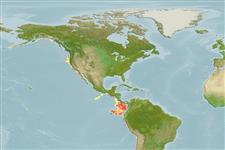Common names from other countries
Классификация / Names
народные названия | синонимы | Catalog of Fishes(род, виды) | ITIS | CoL | WoRMS | Cloffa
>
Ophidiiformes (Cusk eels) >
Ophidiidae (Cusk-eels) > Neobythitinae
Etymology: Porogadus: Greek, poros = porous + Latin, gadus = a fish, cod? (Ref. 45335).
More on author: Garman.
Environment: milieu / climate zone / depth range / distribution range
экология
морской батидемерсальный; пределы глубины 1800 - 4000 m (Ref. 125143). Deep-water; 32°N - 4°S (Ref. 125143)
Eastern Central Pacific.
Size / Вес / Возраст
Maturity: Lm ? range ? - ? cm
Max length : 27.7 cm SL самец/пол неопределен; (Ref. 125143)
Краткое описание
определительные ключи | морфология | морфометрия
This species is distinguished by the following characters: precaudal vertebrae 17-18; long gill rakers on first gill arch 15-18; HL:HD 1.6-1.8 (rarely 1.52-1.6); head spines strong on ethmoidal, sphenotic, outer posttemporal, inner preopercular rim, weak on lacrimal, prefrontal, interorbital, 5th infraorbital, and absent on supraorbital, supratemporal, and outer preopercular rim; opercular spine flat and weak; lower lateral line pores until beginning of anal fin 17-20; vomer with broad dentition patch (2-4 rows); palatines with broad dentition patch (5-7 rows); otolith with single colliculum and step at collum; OL:OH = 1.45-1.65 (Ref. 125143).
Rare species (Ref. 34024). This species is caught mostly between 1800 and 4000 m, rarely up to 1200 m on the lower reaches or the base of the continental slopes. Apparently, it does not appear to venture away from the slope for more than about 500 km (Ref. 125143). Reproductive strategy possibly similar to other members of this family featuring oviparity, with oval pelagic eggs floating in a gelatinous mass (Ref. 205).
Life cycle and mating behavior
Maturities | размножение | Spawnings | Egg(s) | Fecundities | личинки
Schwarzhans, W.W. and P.R. Møller, 2021. Revision of the ‘dragon-head’ cusk eels of the genus Porogadus (Teleostei: Ophidiidae), with description of eight new species and one new genus. Zootaxa 5029(1):001-096. (Ref. 125143)
Статус Красного Списка МСОП (Ref. 130435)
CITES (Ref. 128078)
Not Evaluated
Угроза для людей
Harmless
Использование человеком
рыболовство: интереса не представляет
дополнительная информация
инструменты
Специальные отчеты
Скачать в формате XML
ресурсы в Интернет
Estimates based on models
Preferred temperature (Ref.
115969): 2 - 2.3, mean 2.2 (based on 76 cells).
Phylogenetic diversity index (Ref.
82804): PD
50 = 0.5001 [Uniqueness, from 0.5 = low to 2.0 = high].
Bayesian length-weight: a=0.01000 (0.00244 - 0.04107), b=3.04 (2.81 - 3.27), in cm Total Length, based on all LWR estimates for this body shape (Ref.
93245).
Trophic level (Ref.
69278): 3.6 ±0.6 se; based on size and trophs of closest relatives
устойчивость к внешним воздействиям (Ref.
120179): высокий, минимальное время удвоения популяции до 15 месяцев (Preliminary K or Fecundity.).
Fishing Vulnerability (Ref.
59153): Low vulnerability (24 of 100).
